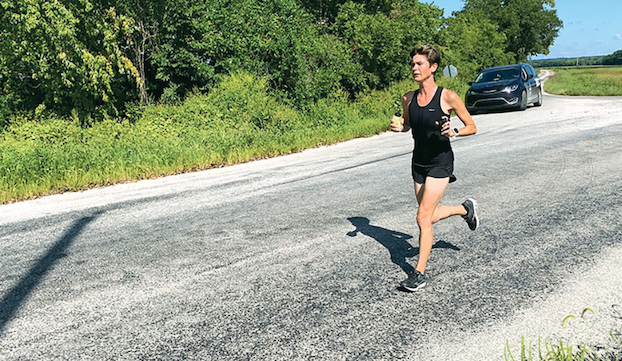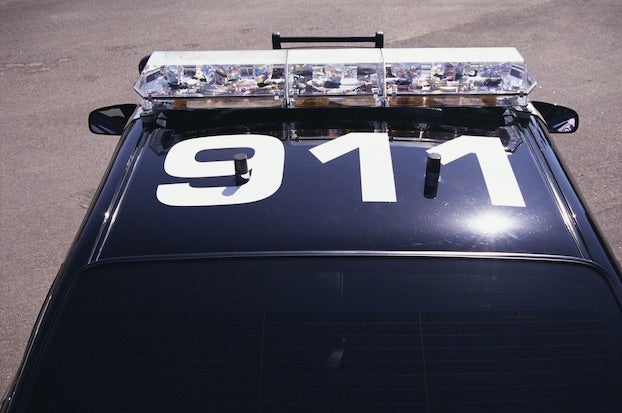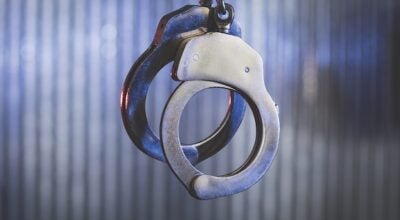Relay of Voices: Couple conveys how lives are shaped by water
Published 8:32 am Sunday, March 26, 2023

- Victoria Bradford began running in 2015. “The new hobby spurred the idea to run home,” she said. “I decided about a year later to run home to Louisiana. I’ve been running away from home all my life and it was a conceptual thing that needed to become physical.” (Special to the American Press)
Stories can connect us. Husband and wife team Tom Styrbicki and Victoria Bradford have put together one an audience can lean into. They look forward to sharing it at 2 p.m. Sunday, March 26, at Riverside Park, 1701 Fitzenreiter Road., Lake Charles.
The event is billed as a lecture, interactive performance about how lives are shaped by water.
“Lecture” might be misleading. This collection of stories was crafted in a singular way – the story-telling itself promises to be just as distinctive. Bradford, a Lake Charles native, is an athlete, writer, performance artist, choreographer and conservationist who studies movement research.
Her husband, an engineer, was still asking questions about the “why,” of the project after they departed their Twin Cities home in July 2019.
The two biked or ran (with a van following) from the headwaters of the Mississippi River at Lake Itasca, Minn., along the twists and turns of the river, to where it ends at the Gulf of Mexico in Venice, Louisiana. They talked to people in cities with large populations and to people in disappearing communities. The 2,400-mile trek took four months, during which they personally and wholeheartedly – Victoria might describe it as whole-bodily – listened to people they met along the way to create Relay of Voices.
On Sunday, hundreds of voices will be distilled down to four.
“We will look at how those four scenes cross many of these stories, woven together across geographies,” Bradford said. “In some cases, you’ll see these cultural narratives that have, in some cases, been hidden, on video.”
The first person they met, a fishing guide, waded into the river while they were visiting with him, to rescue what looked like a message in a bottle. It wasn’t. But it did present a cool opportunity for a science lesson that ended with a blessing.
On a checker-board American Indian Reservation – called that because many Native Americans were fleeced out of their land early on not realizing it could be privately owned any more than the water in the river – Bradford visited with a tribe that is “bringing back the buffalo.”
“They consider the buffalo their relative,” she said. “It’s part of their heritage. We also learned how the casino is revitalizing their economy. It’s the new buffalo.”
It made Bradford think about the economic impact of the Coushatta and Lake Charles casinos. It wasn’t the first glimpse of similarity to her home or the last.
A farmer talked about the industry up and down the river and the relationship between chemicals and the Dead Zone and water quality.
In Louisiana, she visited with “a young man who is back home, and trying to save his town from disappearing.” He takes an active part in local government, plants trees, and talks about what’s happening to Louisiana’s coastline.
With each of the stories, Bradford will pose thought-provoking questions to the audience to include, “Why do we continue to live in threatened environments and make our homes in these places?” (She has asked herself if her home should be here many times.)
“We also want to hear stories from the audience Sunday,” she said. “Who better to find out about life on the many waterways of Southwest Louisiana?”
Bradford did not start running until 2015.
“The new hobby spurred the idea to run home,” she said. “I decided about a year later to run home to Louisiana. I’ve been running away from home all my life and it was a conceptual thing that needed to become physical.”
She didn’t know how to make it happen, what it would look like. She can’t say whether it resolved her own relationship with home and whether she needs to move back and give back to her own community. She believes those answers will come, eventually. The running or cycling – except in the 100 degree temps that she encountered and announced, “I think I’m gonna die” – was not the most difficult aspect of the trip. For her, it was the listening. Sometimes they spent the night in the homes of the people they met and heard more stories over dinner and again at breakfast.
“The physical re-listening is another endurance effort, and it continues,” she said.
She also insisted it was the listening, really listening, that made the journey worthwhile. “If nothing came out of this dance down the river, the listening was enough,” she said.
She thinks when presence is shared, change will occur.
“We may not see it, but it’s there. I just keep listening and I keep writing knowing that somewhere in all of this work something will speak to me. It will happen.”
•
Online: www.relayofvoices.com





